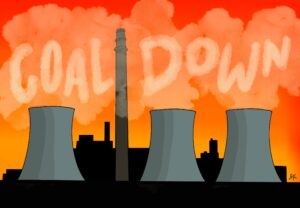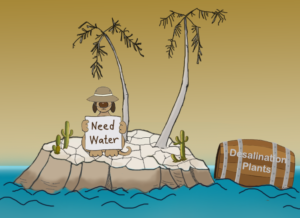
The Question isn’t “What’s in my bag?” it’s “What was my bag before?”: Recycling a Perpetual Environmental Endeavor
I walk over to the disposal area and am faced with a choice. As I place the bottle of water into the recycling bin, a thought appeared in my mind. ‘I have my bottle in my right hand, and my bag in my left, but how are they connected?’ Unbeknownst to me, these two unassuming items hold more in common than I think. In fact, my Herschel EcoSystem backpack is made from recycled and repurposed water bottles. But how does the water bottle turn into a handy backpack that I cart around to class. How does the decision to sort trash translate to other decisions we make on a day-to-day basis?
What’s My Backpack?
Before exploring recycling first we must define it. Recycling is the process of converting waste into reusable material. Oftentimes, near a trash bin a recycling bin will be nearby — blue to indicate recycling. The benefits of recycling have extended from beyond sorting trash and into consumer marketing. For example, when I purchased a Herschel backpack mentioned earlier. I was torn between their regular backpack, or the Eco line. In the Herschel 2022 Impact Report it turns out it took 20 plastic bottles to create my backpack. According to Herschel’s website, the water bottles were “collected, chipped, cleaned, melted, spun and woven into fabric and then sewn into bags” (https://herschel.com/shop/collections/eco). As a consumer of their products, as are many other students, Herschel’s efforts to extend the longevity of the bags has been game changing. The Herschel EcoSystem backpack is an example of a conscious material, or an item created from previously made products. If you are interested in selecting items created consciously it only takes a short amount of time to find the information online.
Can I Recycle This?
According to the EPA, recycling 10 plastic bottles is the equivalent of saving enough energy to power a laptop for more than 25 hours (EPA, 2023). But when stats are mentioned alongside recycling what does it truly mean? When people recycle, it reduces the need to create new materials, allowing the conservation of natural resources. In fact, about 32% of people recycle globally and in the US, about 35% of people recycle (Peysakhovich, 2024). However, it has been reported only 9% of plastic waste is successfully recycled (Hailstone, 2022).
The issues which create the deficit between recycled and successfully recycled plastics are important to recognize. There is unequal access to different recycling programs across the United States. The inconsistency is detrimental and leads to confusion about correct recycling practices. But there are places where recycling standards can be an example for the United States. Let’s look across the pond and we’ll find a plethora of countries in Europe, for example, which have uniform recycling practices. I experienced recycling practices on a research trip to Austria a couple years ago, as I walked over to the trash bin and was dumbfounded. There were six, yes, six different compartments to sort the trash I produced. Initially, I was overwhelmed, but as I read each container and asked my peers what each container was for it became a no brainer. By the end of the trip, I was so used to the sorting system that I missed it when I came back to the States. Another country which has exemplary trash sorting prowess is Sweden, where only 1% of the country’s trash ends up in landfills (Mauborgne and Chan, 2022). When a uniform system is in place it facilitates the adoption of strategies to improve efforts towards initiative such as recycling. The United Nations Environment Program (UNEP) has made efforts to reduce the amount of plastic waste produced by making a Plastic Pollution Deal signed by more than 170 nations (Hailstone, 2022). Recycling and combatting major environmental issues may seem like a monumental issue but there are steps you can take to do your part and add to the solution.
Let’s Hear from a Local Expert
I asked my former classmate Alexander Nelson who works here on Stanford’s campus some questions about recycling. He has been a great resource for myself and others in reducing the complexity surrounding recycling and I thought he’d be a stellar candidate to interview for this topic.
Interview questions included below, TC refers to Teso Coker and AN refers to Alexander Nelson
TC: What is your role and which office do you work for on campus?
AN: ”I currently serve as Zero Waste Outreach and Engagement Specialist with the Office of Sustainability. My role involves managing zero waste engagement in university labs and leading the waste system upgrades for all buildings with labs.”
TC: What is the main goal of your office?
AN: “Our goal is to create a wasteless community here at Stanford. We do this by convening and empowering people, curating data, and stories, and leveraging Stanford’s campus as a living laboratory to advance systems that can scale. The Office of Sustainability is in the process of updating Stanford’s Climate Action Plan, which will include zero waste strategies, and will serve as a comprehensive roadmap outlining specific activities the university will undertake to reduce the impacts of climate change. Students, faculty, and staff can engage in upcoming community forums on April 23 and 24 to contribute ideas.”
TC: What advice would you give students who are having issues with sorting trash?
AN: “Sorting waste can be complicated, but we try and make it as simple as possible.
1. Plastic (containers and film), metals, glass, and paper can be recycled at Stanford.
Top tip: For plastic containers, ensure liquids are emptied and food is scraped out.
2. All food scraps, food-soiled paper (napkins, paper plates, and paper towels), and compostable foodware go into the compost.
Top tip: Look for the word “compostable” on plates, utensils, and cups before sorting into the compost bin.
3. Everything else goes into the landfill.
Top items that go into the landfill are chip bags, snack wrappers, gloves, plastic utensils, and styrofoam.
Here is a waste sorting reference guide.
For anyone interested in learning more, Stanford also provides an online waste sorting training for students.
When in doubt, find out! If unsure about where an item belongs, it’s best to find out to avoid contamination. If you have any questions, get in touch with the Office of Sustainability via this contact form.”
TC: What are the top three biggest issues of concern when it comes to waste disposal on campus that students can help fix?
AN: “The biggest issue of concern regarding waste disposal on campus that students can play a role in is reducing the amount of waste we send to the landfill. This can be achieved by reducing the amount of waste we generate in the first place and properly sorting the rest. Stanford’s most recent waste characterization study revealed that 62% of what we send to landfill is actually recyclable or compostable. The Office of Sustainability is in the process of updating the waste system in buildings across campus to ensure recycling and composting is accessible for students, faculty, and staff. By properly sorting recyclables (plastics, metals, glass, and paper) and ensuring all food scraps go to compost, students can make a big difference in reducing the amount of material we send to landfill, benefiting both the environment and people in the surrounding communities.”
TC: Folks have heard of the 3 R’s: Reduce, Reuse and Recycle. Do you have a similar eco-mantra for the present day?
AN: In addition to the classic 3 R’s (Reduce, Reuse, Recycle), my eco-mantra for the present day emphasizes a holistic approach to sustainability. This includes:
Refuse: Saying no to unnecessary single-use items and adopting a mindset of conscious consumption!
Restore: I am all about DIY repairs, and repurposing junk!
End of interview segment
As I step away from the receptacles for trash I look at all the other students also wearing backpacks. A sea of various brands and colors appear as fellow students rush off to class. A new thought comes to mind. ‘What were those bags before?’
The individual choices we make from placing correct items in recycling to selecting products from repurposed items all lend themselves to our continued effort to make the planet a better place.
Works Cited
“Eco Collection: Herschel Supply Company.” Herschel Supply Co., herschel.com/shop/collections/eco. Accessed 17 Apr. 2024.
Hailstone, Jamie. “Plastic Pollution Deal ‘Marks a Triumph by Planet Earth.’” Forbes, Forbes Magazine, 4 Mar. 2022, www.forbes.com/sites/jamiehailstone/2022/03/02/plastic-pollution-deal-marks-a-triumph-by-planet-earth/?sh=737d57e028a2.
“Impact Report 2022.” Herschel Lifestyle 2023, herschel.com/content/dam/herschel/lifestyle/2023-s2/impact-report/Herschel-Supply-Company_2022-Impact-Report.pdf. Accessed 18 Apr. 2024.
Mauborgne, Renée and Chan, Kim. “Turning Waste to Energy: Sweden’s Recycling Revolution.” Blue Ocean Strategy, 5 Jan. 2022, www.blueoceanstrategy.com/blog/turning-waste-energy-sweden-recycling-revolution/#:~:text=Only%201%25%20of%20Sweden’s%20trash,the%20remaining%2047%25%20gets%20recycled.
Peysakhovich, Roman. “How Many People Recycle in the World? 61 Recycling Statistics.” Cleango, Cleango, Inc., 6 Mar. 2024, www.bookcleango.com/blog/recycling-statistics#:~:text=Key%20Recycling%20Statistics%20and%20Trends,end%20up%20in%20the%20landfill.
“Recycling Basic and Benefits.” EPA, Environmental Protection Agency, 23 Nov. 2023, www.epa.gov/recycle/recycling-basics-and-benefits#:~:text=Benefits%20of%20Recycling-,Environment,and%20minerals%20for%20new%20products.
The views and opinions expressed are those of the authors and do not necessarily reflect nor represent the Earth Chronicles and its editorial board.




